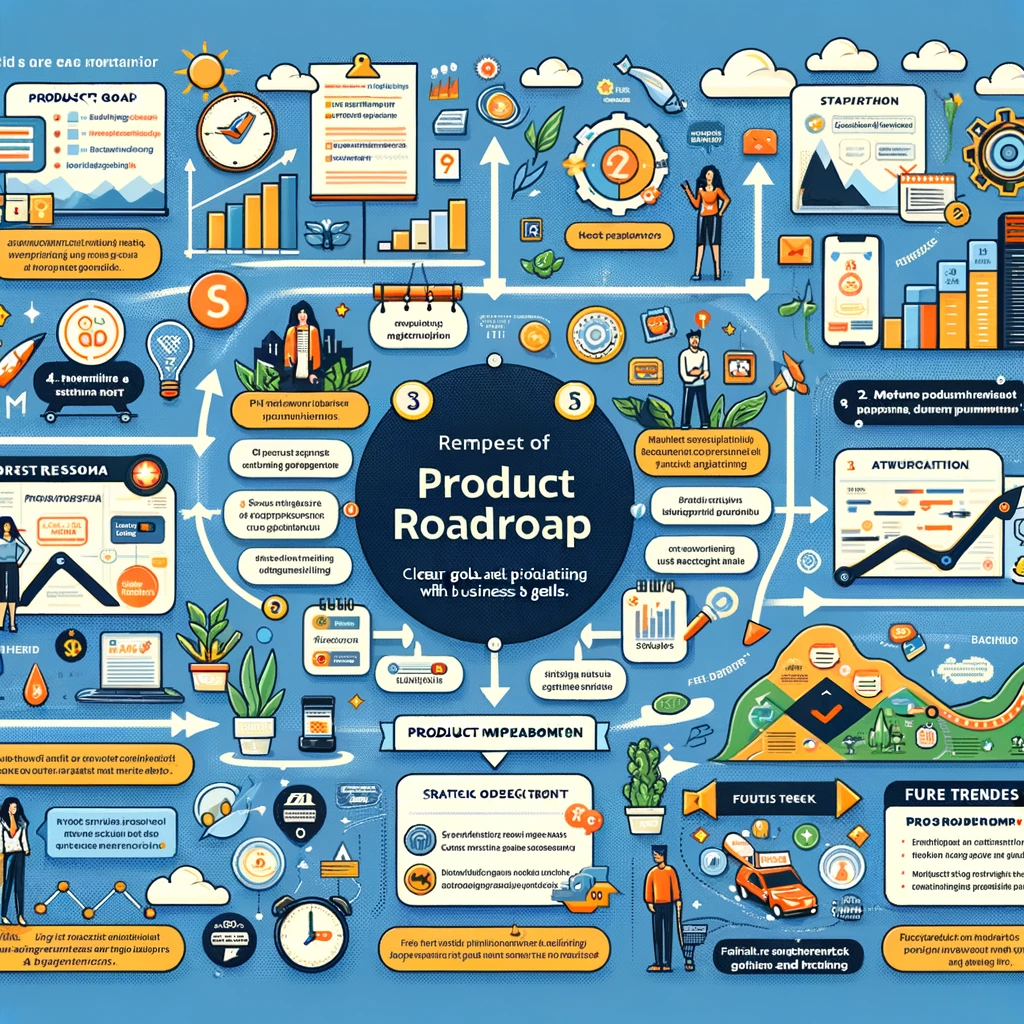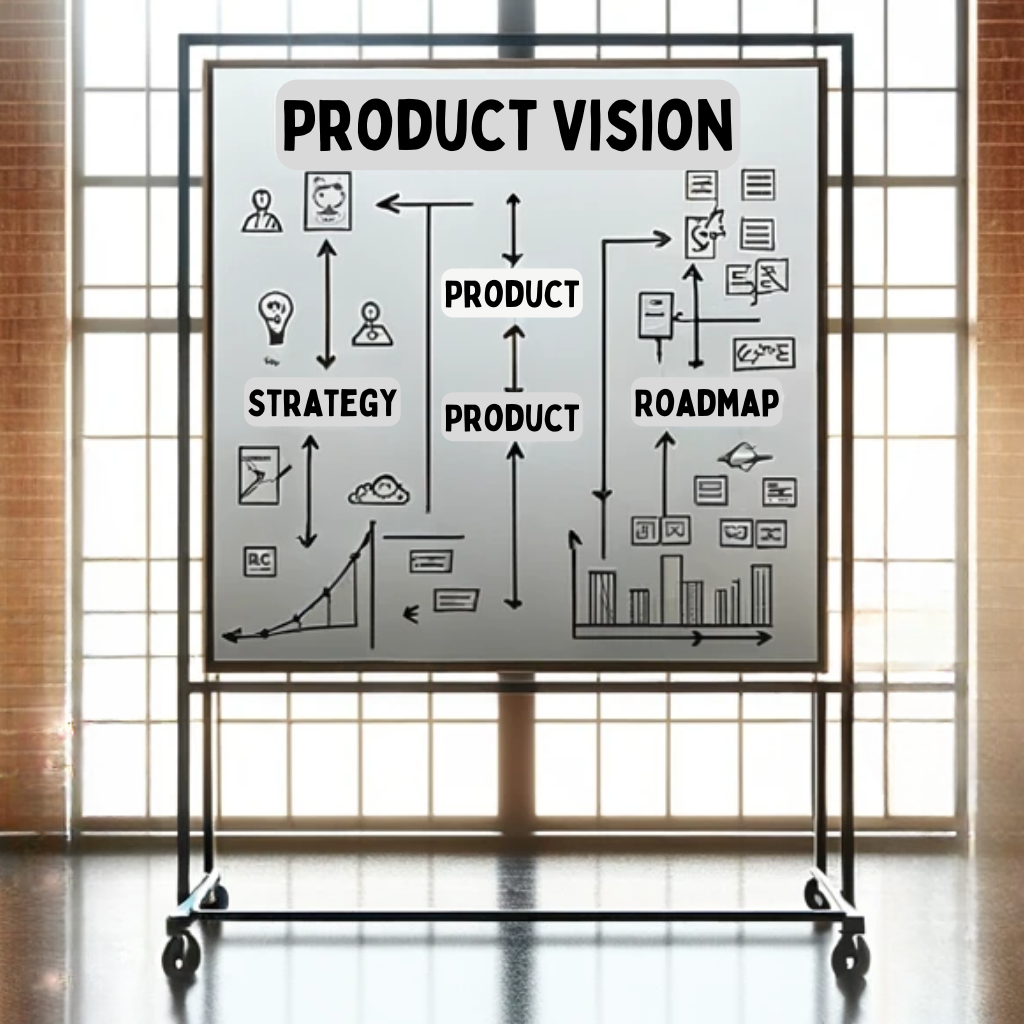Developing a product roadmap is like embarking on a journey with a destination in mind. But how can you ensure your roadmap leads to success? In this ultimate guide, we will dive deep into the strategies and best practices that can help you create a product roadmap that drives results.
A product roadmap is more than just a timeline or a list of features. It is a strategic tool that aligns your business goals with the needs of your customers. By carefully planning and prioritizing your product roadmap, you can optimize resources, minimize risks, and deliver value to your users.
Throughout this guide, we will cover the key steps involved in developing a product roadmap. From conducting market research and identifying customer pain points to setting clear objectives and prioritizing features, we will provide you with a comprehensive roadmap framework.
Whether you are a startup looking to launch a new product or an established company seeking to enhance your existing offerings, this guide will equip you with the knowledge and insights to create a product roadmap that not only drives results but also sets your business on a path to success.
What is a product roadmap?
Product roadmaps are strategic tools essential for guiding the development and success of a product. They act as a high-level visual summary, mapping out the vision, direction, and progress of a product over time. The essence of a product roadmap lies in its ability to communicate not only the “what” and “when” of product development but also the “why” behind these decisions.
Historically, product roadmaps have evolved from simple planning documents to complex strategic guides that integrate various aspects of business, technology, and user experience. In today’s dynamic business environment, a well-crafted product roadmap is more than just a plan; it’s a critical component that aligns product development with overarching business goals, ensuring that resources are effectively allocated, and key milestones are met.
This article delves into the intricacies of creating and managing product roadmaps, providing insights into their key components, development process, and the role they play in the successful realization of product strategies.

Why having a product roadmap is important
A product roadmap is more than just a timeline or a list of features. It is a strategic tool that aligns your business goals with the needs of your customers. By carefully planning and prioritizing your product roadmap, you can optimize resources, minimize risks, and deliver value to your users.
Having a clear product roadmap is crucial for several reasons. Firstly, it provides a shared vision and direction for your team. It helps everyone understand the overarching goals and priorities, fostering collaboration and alignment across different departments. Secondly, a well-developed product roadmap enables effective resource allocation. By identifying the most important features and initiatives, you can allocate your resources strategically, ensuring that you are investing time and effort in the right areas. Lastly, a product roadmap is essential for communicating with stakeholders, investors, and customers. It demonstrates your long-term vision and commitment to delivering value, and building trust and confidence in your brand.
Key components of a successful product roadmap
A successful product roadmap consists of several key components that work together to drive results. These components include:
1. Clear Goals and Objectives: The foundation of any roadmap is a clear set of goals and objectives. These should align with the broader business strategy and address specific market needs or opportunities. Read more about product goals
Before you start creating your product roadmap, it’s essential to define your goals and objectives. What do you want to achieve with your product? Are you looking to increase customer acquisition, improve user retention, or enter new markets? By setting clear goals, you can align your roadmap with your business strategy and ensure that every feature and initiative contributes to your overall objectives.
2. Market Research and Customer Needs: Due to limited resources and time, not every desired feature or initiative can be pursued. Prioritization involves making strategic decisions about which projects to pursue first based on factors like customer value, market impact, and resource availability.
To develop a product roadmap that truly drives results, you need to understand your target market and the needs of your customers. Conduct thorough market research to identify trends, competitive landscape, and customer pain points. Use this information to inform your roadmap and prioritize features that address the most critical needs of your target audience.
3. A Timeline: A roadmap must outline a realistic timeline for achieving its goals. This includes setting milestones for key development phases, product launches, and updates while being flexible enough to adapt to unforeseen challenges or opportunities.
4. Prioritization and Trade-offs: Prioritization is a crucial aspect of developing a product roadmap. Not every feature or initiative can be included, so you need to make trade-offs. Consider factors such as customer value, technical feasibility, and business impact when prioritizing features. Use techniques like the MoSCoW method (Must-haves, Should-haves, Could-haves, Won’t-haves) or the RICE framework (Reach, Impact, Confidence, Effort) to help you make informed decisions. Read more about Prioritization
Together, these components form the backbone of a product roadmap, transforming it from a mere schedule of product releases into a strategic tool that guides the entire product lifecycle.
The Interplay Between Product Strategy and Product Roadmap
The relationship between product strategy and product roadmap is symbiotic and essential for successful product development:
- Strategic Blueprint: The product strategy acts as a blueprint, defining the overarching goals, target market, and competitive positioning of the product.
- Tactical Execution Plan: The product roadmap translates this strategy into a tangible execution plan. It outlines the specific features, enhancements, and timelines required to realize the strategic vision.
Together, the strategy sets the direction and objectives, while the roadmap provides a detailed path for achieving these objectives, ensuring coherence and focus in product development efforts.

Crafting an Agile Product Roadmap
Transitioning from Product Strategy to Roadmap. Crafting an agile product roadmap requires balancing long-term vision and short-term flexibility. Begin by defining a clear, overarching product vision to guide the roadmap. This vision should be rooted in customer needs and market trends, providing a north star for all roadmap decisions. Then, break down this vision into strategic themes or goals that can be pursued over time. Each theme should be high-level, allowing for adaptation as you learn more about your users and the market. Adopt a time horizon that is long enough to provide direction, but short enough to remain relevant in a fast-changing environment, typically ranging from 6 to 18 months. Within this frame, use a rolling-wave planning approach, revisiting and updating the roadmap at regular intervals, such as quarterly. This method ensures the roadmap stays aligned with current user feedback and market conditions. Incorporate feedback loops in your development process, using iterative releases to gather user insights and adjust the roadmap accordingly. Lastly, ensure transparency and open communication with all stakeholders about the roadmap’s progress and any changes, fostering a culture of collaboration and continuous improvement. This approach balances long-term vision with the agility needed to respond to change, making your roadmap a living document that evolves with your product.
The process of creating a product roadmap involves several key steps, each critical for ensuring that the roadmap is both effective and achievable.
Let’s look at the process step by step:
- Conducting Market Research: Understanding the market is vital. This includes analyzing trends, identifying customer needs, and monitoring competitors. Such research informs the roadmap by highlighting the most relevant and impactful opportunities.
- Setting Strategic Objectives: Based on the market research, set clear, achievable objectives that align with the company’s broader goals. These objectives serve as guiding beacons for the entire roadmap.
- Market and User Research: Incorporate insights from market analysis and user feedback to ensure the roadmap aligns with customer needs and market trends.
- Prioritizing Features and Creating a Timeline: Evaluate and prioritize features based on customer value, technical feasibility, and business impact. Then, organize these features into a structured timeline, factoring in dependencies and resource constraints.
- Capacity Assessment: This involves understanding the amount of work your team can handle in a given period. It’s essential to know your team’s capacity to avoid overcommitting and under-delivering. Capacity planning should consider factors like team size, skill levels, holidays, and other commitments.
- Balancing Planning with Flexibility: While it’s important to have a structured plan, an agile roadmap should not be overly rigid. The combination of capacity and velocity assessment with a buffer allows for a balance between structure and adaptability.
- Roadmap Development: Translate these priorities into a timeline, creating a roadmap that details when and how each aspect of the strategy will be implemented.
- Regular Review and Adaptation: Continuously revisit and adjust the roadmap to reflect changes in strategy, market conditions, and user feedback.
This process is key to developing a roadmap that not only guides product development but also ensures alignment with market needs and organizational goals.
1. Conducting market research and identifying customer needs
To develop a product roadmap that drives results, you must first understand your target market and the needs of your customers. This requires conducting thorough market research and gathering valuable insights. Here’s how you can go about it:
1. Define your target audience: Start by clearly defining your target audience. Who are your ideal customers? What are their demographics, behaviors, and preferences? By understanding who you are targeting, you can tailor your product roadmap to meet their specific needs.
2. Analyze the market: Conduct a comprehensive analysis of the market you operate in. Identify key trends, competitors, and potential opportunities. This will help you identify gaps in the market and areas where your product can differentiate itself.
3. Gather customer feedback: Talk to your existing customers and gather their feedback. What pain points do they experience? What features or improvements would they like to see? This information will be invaluable in shaping your product roadmap and prioritizing features.
Once you have gathered all the necessary insights, you can start mapping out your product roadmap based on the needs and preferences of your target audience. Remember to prioritize features that provide the most value and align with your business goals.
2. Setting clear goals and objectives for your product roadmap
A product roadmap without clear goals and objectives is like a ship without a compass. To ensure your roadmap drives results, it’s essential to set clear goals and objectives from the start. Here’s how you can do it:
1. Define your business goals: Start by defining your high-level business goals. What do you want to achieve with your product? Are you looking to increase revenue, expand into new markets, or improve customer satisfaction? Clearly articulate your goals to provide a strategic framework for your product roadmap.
2. Break down your goals into objectives: Once you have defined your business goals, break them down into specific objectives. Objectives should be measurable, achievable, and aligned with your overall goals. For example, if your goal is to increase revenue, your objectives could be to launch a new pricing strategy, upsell to existing customers, or expand into new markets.
3. Align your roadmap with your objectives: With your goals and objectives in place, align your product roadmap to ensure that each feature and initiative contributes to achieving those objectives. Prioritize features that directly address your objectives and have a clear impact on your business goals.
By setting clear goals and objectives, you provide a strategic framework for your product roadmap, ensuring that every feature and initiative is aligned with your overall business strategy.

3. Prioritizing features and creating a timeline
One of the most critical aspects of developing a product roadmap is prioritizing features and creating a timeline. Here’s how you can effectively prioritize features and create a timeline for your roadmap:
1. Assess customer value: Start by assessing the customer value of each feature. Which features are essential for your customers? Which ones will provide the most value and address their pain points? Prioritize features that have a direct impact on customer satisfaction and retention.
2. Consider technical feasibility: Evaluate the technical feasibility of each feature. Can it be developed within the desired timeline? Are there any technical constraints or dependencies that need to be considered? Prioritize features that are technically feasible and align with your development capabilities.
3. Evaluate business impact: Assess the business impact of each feature. Will it contribute to revenue growth, cost reduction, or market expansion? Prioritize features that have a clear impact on your business goals and objectives.
Once you have prioritized the features, it’s time to create a timeline for your roadmap. Break down your features into smaller milestones and allocate resources and timelines accordingly. Consider dependencies, resource availability, and any other factors that may impact the timeline.
Read more about prioritisation frameworks
4. Capacity Assessment
Conducting a capacity assessment is a crucial step in creating your roadmap. It ensures that the roadmap is realistic and achievable given the resources available. Here’s a structured approach to doing a capacity assessment:
1. Resource Inventory: List all available resources, including team members, tools, and budget.
2. Skills and Expertise: Evaluate the skills and expertise of your team to understand what tasks they can handle efficiently.
3. Historical Performance: Review past project data to gauge how much work your team can handle without overstretching.
6. Balancing Planning and Flexibility
While it’s important to have a structured plan, an agile roadmap should not be overly rigid. The combination of capacity and velocity assessment with a buffer allows for a balance between structure and adaptability.
1. Incorporating a Buffer: Why a Buffer is Important: No matter how well you plan, unforeseen challenges can arise—technical issues, market conditions, or team changes. A buffer often called a contingency or slack time, helps accommodate these uncertainties.
2. How to Add a Buffer: You might allocate a certain percentage of your roadmap’s timeline as a buffer, or you might include buffer periods between major milestones. The buffer should be reasonable—not too large that it encourages laxity, but sufficient to absorb shocks.
7. Roadmap Development
When you understand your capacity and resources, translate the priorities into a timeline, creating a roadmap that details when and how each aspect of the strategy will be implemented.
1. Set clear objectives and goals.
2. Decide the timeframe (e.g., quarterly, or annually).
3. Determine the level of detail and granularity needed.
4. Sequence features and initiatives based on priorities and dependencies.
5. Allocate tentative timelines for each phase or feature.
8. Regular Review and Adaptation
Continuously revisit and adjust the roadmap to reflect changes in strategy, market conditions, and user feedback.
Different Types of Product Roadmaps
Product roadmaps can vary based on their purpose, audience, and the product’s lifecycle stage. Here are some common types:
- Visionary Roadmaps: Focus on the long-term vision of the product, often used for communicating with stakeholders and investors.
- Features Roadmaps: Detail specific features and enhancements planned for the product, typically used by development teams.
- Release Roadmaps: Outline the schedule for product releases, including major launches and updates.
- Strategy Roadmaps: Align the product’s development with the company’s strategic goals, useful for internal decision-making.
- Technology Roadmaps: Focus on the technological evolution of the product, guiding the development team on tech trends and tools.
Each type serves a different purpose, catering to various aspects of product development and stakeholder engagement.
Creating Roadmaps for Different Types of Stakeholders
Creating different roadmaps for various stakeholders is important due to the distinct roles, concerns, and interests each group holds:
- Executives: Focus on strategic alignment and high-level goals. Simplify technical details and emphasize how the roadmap aligns with business objectives and ROI.
- Development Teams: Include technical specifications, detailed timelines, and feature breakdowns. Ensure clarity on dependencies and resource allocation.
- Sales and Marketing Teams: Highlight key features and release dates that align with marketing campaigns and sales strategies. Include market trends and customer feedback that inform the roadmap.
- Customers/Users: Create user-friendly, high-level roadmaps. Focus on upcoming features and enhancements that address their needs and concerns.
Each roadmap should be tailored to its audience, ensuring clarity, relevance, and alignment with their specific interests and requirements.

Collaborating on the Product Roadmap
Developing a product roadmap requires collaboration with cross-functional teams and stakeholders. Here’s how you can effectively collaborate and ensure everyone is aligned:
1. Involve key stakeholders early: Engage key stakeholders from different departments early in the roadmap development process. This includes product managers, developers, marketers, and executives. By involving them from the beginning, you can gather valuable insights and ensure their buy-in.
2. Foster open communication: Create an environment of open communication and collaboration. Encourage cross-functional teams to share their perspectives and ideas. This will help uncover potential issues and ensure everyone is aligned on the roadmap.
3. Conduct regular roadmap reviews: Schedule regular roadmap reviews with stakeholders to gather feedback and make necessary adjustments. This will help you address any concerns or changes in business priorities, ensuring that your roadmap remains relevant and aligned with the overall strategy.
By collaborating effectively with cross-functional teams and stakeholders, you can ensure that your product roadmap is well-informed, aligned with business objectives, and supported by all relevant parties.
Monitoring and adjusting your product roadmap
A product roadmap is not set in stone. It requires continuous monitoring and adjustment to remain relevant and effective. Here’s how you can monitor and adjust your product roadmap:
1. Track key metrics: Define key metrics that will help you measure the success of your roadmap. These metrics can include user engagement, revenue growth, customer satisfaction, or any other relevant KPIs. Regularly track and analyze these metrics to assess the impact of your roadmap and make data-driven decisions.
2. Responding to Feedback and Market Changes: Continuously gather user feedback and stay alert to market trends. Adjust the roadmap as necessary to reflect new insights, changing market conditions, or shifts in business strategy.
3. Iterate and adjust: Based on the insights gathered from metrics and user feedback, iterate and adjust your roadmap as needed. This may involve reprioritizing features, adding new initiatives, or even removing certain features that are not delivering the expected results.
By monitoring and adjusting your product roadmap based on real-time data and user feedback, you can ensure that it remains aligned with business objectives and continues to drive results.
Tools and resources for developing and managing a product roadmap
Several tools and resources can help you develop and manage your product roadmap effectively. Here are some popular ones:
1. Product management software: Use product management software like Jira, Trello, or Asana to create and manage your product roadmap. These tools provide features such as task management, collaboration, and timeline visualization, making it easier to plan and execute your roadmap.
2. Roadmap templates: Utilize roadmap templates to create a visual representation of your roadmap. Templates like Gantt charts or swimlane diagrams can help you communicate your roadmap to stakeholders in a clear and concise manner.
3. Customer feedback tools: Leverage customer feedback tools like Intercom, UserVoice, or SurveyMonkey to gather user feedback and insights. These tools enable you to collect feedback at scale, analyze trends, and make informed decisions based on user preferences.
4. Analytics tools: Use analytics tools like Google Analytics or Mixpanel to track key metrics and measure the success of your roadmap. These tools provide valuable insights into user behavior, engagement, and conversion rates.
By utilizing these tools and resources, you can streamline your roadmap development process, improve collaboration, and make data-driven decisions to drive results.
Challenges in Roadmap Development
Developing a product roadmap is not without its challenges:
- Balancing Different Perspectives: Balancing the needs and perspectives of various stakeholders, including customers, team members, and executives, can be challenging.
- Managing Scope and Resources: Avoiding scope creep while effectively managing limited resources is crucial for maintaining a realistic and achievable roadmap.
- Adapting to Change: The roadmap must be flexible enough to adapt to unexpected changes in market conditions, technology, or business priorities.
Addressing these challenges requires a strategic approach, clear communication, and a willingness to adapt as necessary.
Future Trends in Product Roadmaps
Looking ahead, several key trends are likely to shape the future of product roadmap development:
- Increased Emphasis on User Experience: As markets become more customer-centric, roadmaps will increasingly focus on enhancing user experience and satisfaction.
- Integration of AI and Data Analytics: Advanced analytics and AI will play a bigger role in informing roadmap decisions, offering deeper insights into customer behavior and market trends.
- Agile and Flexible Planning: The shift towards more agile and iterative development methodologies will require roadmaps to be more adaptable and responsive to change.
These trends indicate a move towards more dynamic, data-driven, and user-focused product roadmaps in the future.
The Role of AI in Generating Product Roadmaps
The integration of Artificial Intelligence (AI) in product roadmap development is an emerging trend with significant potential:
- Predictive Analytics: AI can analyze vast amounts of data to predict market trends and customer preferences, helping to prioritize features more effectively.
- Automated Insights: AI tools can provide automated insights into user behavior, enabling more data-driven decision-making.
- Enhancing Collaboration: AI can streamline the collaboration process by offering predictive suggestions, automating routine tasks, and facilitating communication across teams.
The use of AI in product roadmaps represents a shift towards more efficient, intelligent, and data-driven product development strategies.
Conclusion: How a well-developed product roadmap can drive results
In summary, a well-structured product roadmap is a critical tool in the arsenal of successful product management. It serves as a guiding document that aligns product development with strategic business goals and user needs.
It aligns your business goals with the needs of your customers, optimizes resource allocation, and fosters collaboration and alignment across teams.
By conducting market research, setting clear goals, prioritizing features, collaborating effectively, and continuously monitoring and adjusting your roadmap, you can create a roadmap that not only drives results but also sets your business on a path to success.
Remember, developing a product roadmap is an iterative process. It requires continuous learning, adaptation, and alignment with changing market dynamics. By following the strategies and best practices outlined in this ultimate guide, you will be well-equipped to develop a product roadmap that drives results and positions your business for long-term success.
The creation and maintenance of an effective roadmap involve clear goal-setting, prioritization, collaboration, and adaptability. As we’ve explored, mastering the art of roadmapping is not just about logistical planning but also about embracing a flexible, data-informed approach that can respond to changing market dynamics. With the right tools, strategies, and an eye on future trends, a product roadmap can be a powerful instrument for navigating the complex journey of product development and market success.
You can also watch the Product Disorder on Youtube here.
FAQ about Product Roadmap
What is a product roadmap?
A product roadmap is a strategic plan that outlines the vision, direction, and progress of a product over time.
Why is a product roadmap important?
It aligns product development with business goals, provides clear direction, and helps in prioritizing features.
Who should be involved in creating a product roadmap?
It typically involves cross-functional collaboration, including product management, engineering, marketing, and sales teams.
How often should a product roadmap be updated?
It’s a dynamic document that should evolve based on new information and changing circumstances. It should be regularly reviewed and updated, especially in response to market changes, user feedback, or internal strategy shifts.
What tools are used for creating a product roadmap?
Common tools include product management software like Jira, Trello, or Asana, and analytics tools like Google Analytics.
How does AI influence product roadmap development?
AI can enhance roadmap development through predictive analytics, automated insights, and improved collaboration efficiency.